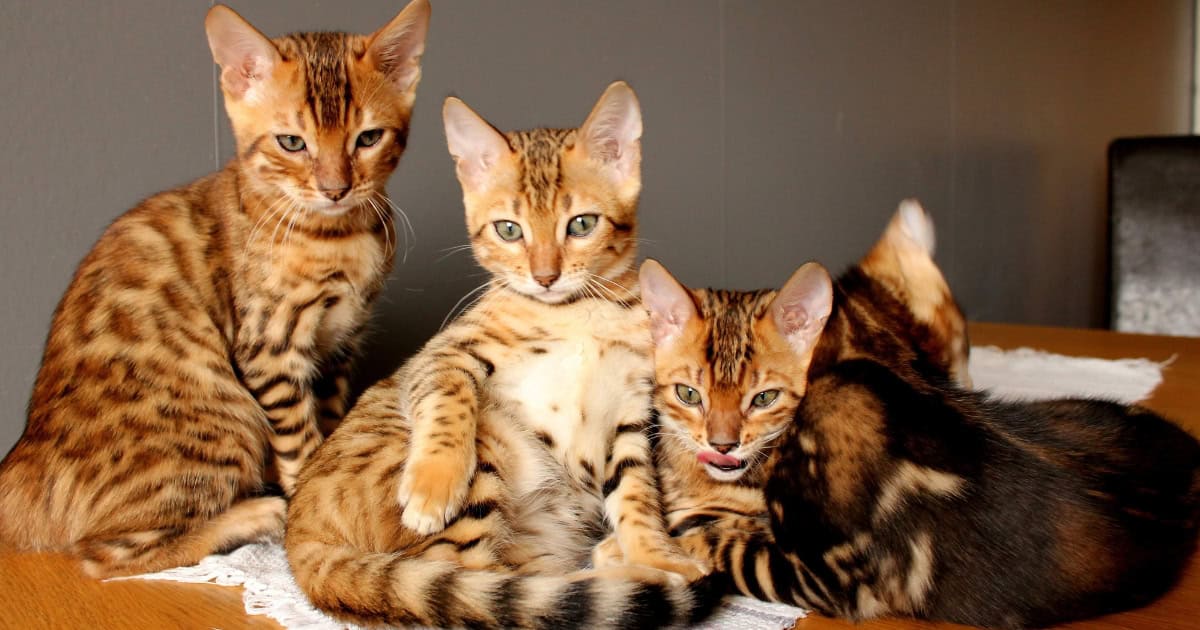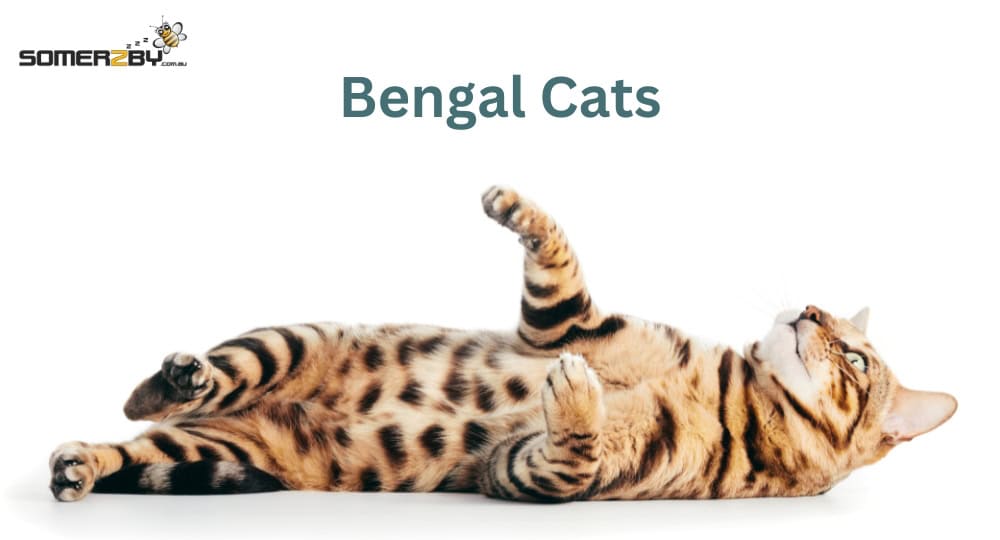Cats, Info Guides
Bengal Cats
- What it’s Like Owning a Bengal Cat?
- Things To Know About Bengal Health
- Are Bengal Cats Good House Pets?
- Do Bengal Cats Like To Be Held?
- Are Bengal Cats Dangerous?
- Male or Female Bengal Cat?
- Are Bengal Cats Indoor Cats?
- How Big Is an Adult Bengal Cat?
- What Does a Bengal Cost?
- Should I Get a Bengal Cat?
Bengal Cats came about as the result of an accidental cross in the 1960s between a wild cat, the wild Asian Leopard cat (Felis Bengalensis), and a domestic tabby.
Formal breeding programmes restarted in 1981.
And thanks to the tireless efforts of Jean Mill and Dr. Willard Centerwall the Bengal cat has become a really popular choice with cat lovers throughout the world.
The low shedding coat is typically dense with a soft silky feel and requires little grooming.
This makes it a great choice for homes where a mild to highly hypoallergenic cat is a requirement.
The spot patterns are typically randomly positioned and may be spotted, rosette or take on a more marbled appearance.
The International Cat Association awarded the Bengal full breed recognition in 1991 and other organisations have since followed suit including the * American Cat Fanciers Association (ACFA), and The International Cat Association (TICA).
What It’s Like Owning a Bengal Cat?
Anyone looking to share their homes with a Bengal cat needs to be prepared for a full-on high energy bundle of some of the most intensely cat-like behaviour you’ve ever known.
Bengal cats are incredibly intelligent and will respond well to training.
You can train your Bengal cat to respond to its name, fetch objects, learn to sit, stay, and other tricks if you start when they’re young enough.
Bengal cats will accept being taken for walks whilst on a harness and leash, which is a real boon given their high exercise needs.
They adore challenging puzzles and will easily learn from watching you.
So don’t be surprised when your cat learns to turn door knobs, open random computer programmes, or simply flush your toilet for the pleasure of watching the water swirl.
Your Bengal will keep you endlessly entertained with its antics. But it is vital to keep your Bengal sufficiently entertained and mentally stimulated.
Otherwise you run the risk of turning your Bengal cat into a real tiger of destruction with unpleasant results including shredded curtains, damaged furniture, and missing or broken objects.

Bengal cats are deeply affectionate and loyal and will usually bond really well with children, other cats, and even dogs if you socialise them early enough.
Try to socialise them with as many people and animals as possible before they reach 3 months old to avoid any personality problems.
Even so, they will sometimes become a one-person cat, bestowing their most intensely loyal devotion on that one special person in the house.
They love climbing and their ability to jump to great heights may see them find perches in the most surprising places such as atop doors, fridges or bookcases where they can leap onto unsuspecting passersby.
They usually love water and you may find that your cat will want to join you in the shower or bath. And, if you have goldfish you will need to find a cat proof cover because the Bengal Cat is very proficient at fishing.
Another very distinctive feature is their kitten-like very appealing meow.
They can be quite vocal cats and will tell you about everything that is happening in their life.
What You Need To Know About Bengal Health?
Although Bengal cats are very hardy cats they, like any other cat breeds, can be prone to a number of health problems.
Making sure your cat has its vaccinations up to date and providing a healthy diet along with adequate exercise will help to ensure your cat remains in top form.
As a rule, a Bengal cat will live for 12 to 16 years.
Here are some conditions to watch out for:
Hypertrophic Cardiomyopathy or HCM
This is a genetic form of heart disease that can lead to abnormal thickening of heart wall muscles, the development of blood clots and congestive heart failure.
This condition is often passed on as a recessive gene so it may not appear for several generations.
Progressive Retinal Atrophy
This degenerative eye disease leads to premature blindness. Cataracts are another eye condition that can show up in Bengal cats.
Ask breeders if they test for this condition before you purchase from them.
Patellar Luxation
This is another hereditary condition that can trigger dislocation of the kneecap and can lead to arthritis. Maintaining a health cat weight may help prevent this.
Are Bengal Cats Good House Pets?
For the right owner, the Bengal cat breed make a great house cat.
If you are prepared to devote the time to training and socialising your new Bengal well they will reward you with years of devoted affection and entertainment.
As with any animal take the time to introduce new arrivals slowly watching out for any signs of aggression.
Bengals are very territorial but they can learn to coexist very happily with almost any other house pet and family members.
As with any pet a bored, lonely Bengal can be destructive so make sure they have the attention, mental stimulation and exercise they need to prevent this.

Do Bengal Cats Like To Be Held?
Bengals will dole out large dollops of affection in between times of racing around, chasing and playing games.
If they have been used to it from a young age they will lap up all the attention you can give them including being held and stroked.
They will do head bumps to show you they adore you and will happily curl up to sleep with you for hours on the bed after a good solid bit of blanket paddling.
Many Bengal cat breed owners report that their cats love to jump on their shoulders as they go around their daily activities.
They love being groomed and will happily consent to your attentions.
Are Bengal Cats Dangerous?
The Bengal cat’s reputation for fierceness is something of a myth. They do not have wild, feral natures as some people have reported.
In fact, a Bengal cat is no more fierce than any other domestic breed.
However, they are powerful, muscular cats and so natural playful biting and rear leg kicking behaviours may cause some real damage to people and other animals.
Fortunately, Bengal cats can be easily trained out of this behaviour from a young age by clearly letting the cat know that it is unacceptable through the use of a sharp hiss.
The more time you spend training (including clicker training on a lead, and teaching verbal commands such as sit and stay) and socialising your cat from a young age the fewer personality problems your cat will have.
Bengal cats are territorial but again adequate socialisation will help prevent problems within your home boundaries.
Is It Better To Have A Male or Female Bengal Cat?
If you are only looking for pet then either a male or female will be fine provided you have them neutered. On the whole a neutered cat will be much happier, cleaner cat to have in your home.
If you’re looking to breed Bengal cats then you need to be aware of the challenges.
Male unneutered cats will display some very undesirable habits (from a homeowner’s perspective) including:
- Spraying
- Fighting
- Roaming
Unneutered female cats too can be a real handful especially during their breeding season. You may have to deal with:
- Constant calling for a male
- Potential unwanted litters

Are Bengal Cats Indoor Cats?
Bengal cats are often kept indoors and can be easily trained to use a litter box.
They like most other cat breeds will want keep these home space immaculately clean.
Be aware though that if you have an unneutered male it will start spraying around the house to leave its scent.
Home owners will love the low shedding quality of Bengal cats and you won’t be constantly cleaning cat hair off the furniture or carpet.
This makes them a great choice for allergy sufferers too.
Bengal cats are incredibly inquisitive and love to explore. This includes jumping up on shelves and potentially knocking objects such as pot plants, cups or bowls to the floor.
In other words you’ll probably want to make some changes to cat-proof your home.
Bengal cats crave lots of exercise and you will need to ensure they get these needs met on a daily basis otherwise they may become bored and destructive.
In many cases, Bengal cats may be better kept inside. Their exceptional innate hunting skills means they pose a real threat to native birds and wildlife as well as other pets.
You may want to consider installing a large outdoor cat enclosure or cat run or making sure you have an escape proof yard where they can safely run and play to their heart’s content.
How Big Is An Adult Bengal Cat?
An adult male Bengal cat can measure up to 44cms (excluding tail) long and can weigh as much as 8kgs.
A female adult is usually a little smaller at 35 to 40 cms long and coming in at about 6.5 to 7kgs.
Because the wild Asian Leopard cat is much larger than a domestic cat an F1 generation cat (one with an Asian Leopard cat parent) will be much larger than an F3 or F4 generation Bengal cat.
The type of domestic cat used to breed with an Asian leopard cat will also play a role in determining the size of successive generations of Bengal cats in that bloodline.
Bengal cats are larger than most domestic cats however, there are a number of domestic cat breeds that are considerably larger again than the Bengal.
The Maine Coon and Ragdoll cat breeds are both significantly longer and taller than the Bengal.
What Does A Bengal Cat Cost?
The cost of purchasing a Bengal cat will vary a lot depending on a number of things including breed quality and history, sex, age, and show status.
A de-sexed, vaccinated kitten could cost anywhere from $450 to $1800. A high pedigree show cat could be $2,500 or more.
You may find some breeders have older cats or cats that are not quite up to show standard that they’re willing to let go of for a lower price.
But it really pays to do lots of research both about the Bengal breed and any potential breeders you might be considering approaching.
Should I Get A Bengal Cat?
Remember, a Bengal cat is not a feed and forget quiet kind of cat.
They are full of life and fun and for some people their high levels of curiosity and activity can be a bit too full on.
They can be too much ‘in your face’ for some people who don’t realise that a Bengal loves to be:
- The centre of attention
- In on all the action
- The big boss of the home
- Loved and adored by all
Remember, they can be vocal and will not just sit quietly waiting for meals to come at your convenience.
Furthermore, you need to spend time training and socialising your cat.
You need to ensure you’re committed to providing the mental stimulation and exercise these cats need otherwise a Bengal cat is not for you.
If you are willing to make the time and effort to providing the best home for your cat then you find that sharing a home with a Bengal cat is a deeply rewarding joy.





